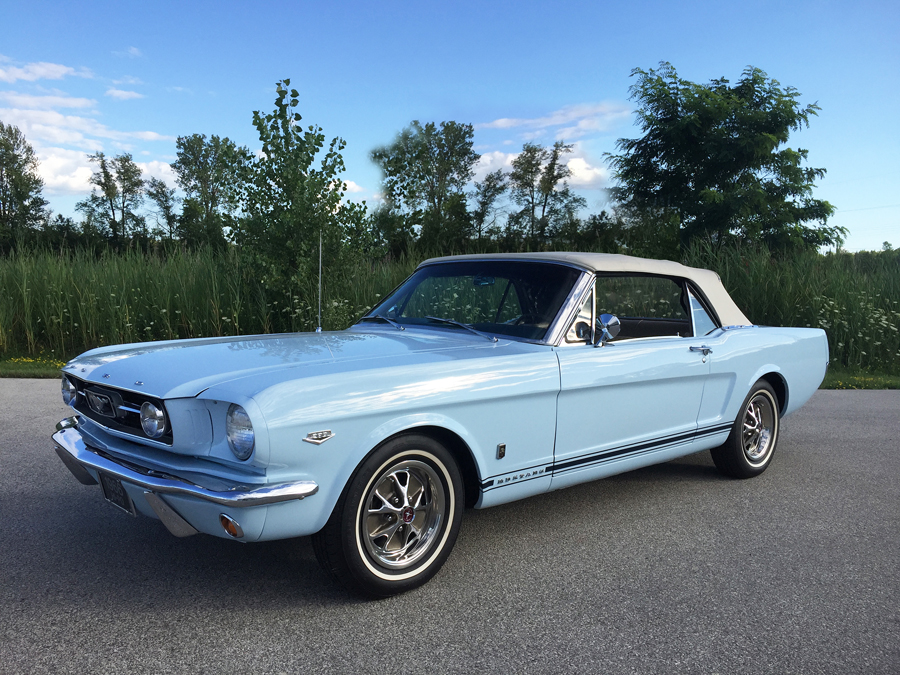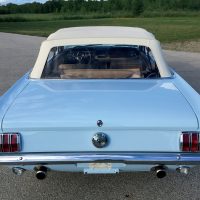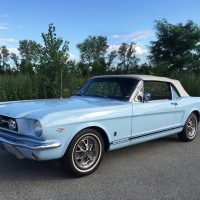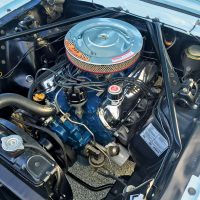- K-code 289-ci HiPo V8 engine
- 4-speed manual transmission
- Restored by marque expert Fred Glazier Jr.
- Displayed at the Simeone Museum
- Very correct with numerous and extraordinarily rare specific K-code FoMoCo parts
- All exterior sheet metal is original Ford (as noted by Fred Glazier)
- Customer-ordered per factory buck tag
- Deluxe “Pony” interior
- Very rare factory build sheet
- Factory AM radio/8-track stereo
- Original documents and receipts pertaining to the restoration
- Rally Pac gauge cluster
- Bucket seats with seat belts and center console
- Emergency flasher switch in glovebox
SCM Analysis
Detailing
| Vehicle: | 1966 Ford Mustang GT K-Code Convertible |
| Years Produced: | 1965–67 |
| Number Produced: | 13,231 (all body styles) |
| Original List Price: | $3,825 (as equipped) |
| SCM Valuation: | Median to date, $44,100; high sale, $132,000 |
| Tune Up Cost: | $300 |
| Distributor Caps: | $25 |
| Chassis Number Location: | Driver’s side fender apron |
| Engine Number Location: | Front of the passenger’s side of the block — above the oil pan |
| Website: | http://www.mustang.org |
| Alternatives: | 1966 Chevrolet Corvette L79 convertible, 1966 Pontiac GTO convertible, 1967 Chevrolet Camaro RS/SS convertible |
| Investment Grade: | B |
This car, Lot 141, sold for $77,500, including buyer’s premium, at Auctions America’s Hilton Head, SC, sale on November 5, 2016.
The introduction of the Ford Mustang was a thrilling success. From its humble out-of-the-gate beginnings as a sporty coupe or convertible, the Mustang quickly morphed into something else — a performance machine.
It was, spontaneously, the birthplace of the Pony-car revolution — the car that started it all. The Mustang was fun, exciting and well designed. Carroll Shelby soon decided to squeeze out its true potential as a high-performance track and street car.
From a simple idea to build an affordable, sporty car for the masses, the Mustang literally transformed the 1960s into one of the most exuberant milestones of American automotive performance and design.
Enter the K-code
The K-code high-performance engine — known as the HiPo 289 — was first introduced in 1963, and it found its way into the Fairlane and Comet.
Carroll Shelby knew that the spunky V8 was the perfect engine for his new 1965 GT350, and the good folks at Ford were happy to oblige. Ford wanted the Shelbys to dominate the track and street — which only served to energize the Mustang mystique. Ford also wanted Mustang buyers to check the rambunctious, solid-lifter “K” engine as an option for any of the Mustang body styles — the humble coupe, racy fastback or sporty convertible.
Out of the box, the K-code 289 made 271 horsepower (306 in the modified Shelbys) — ever so near the one-horsepower-per-cubic-inch milestone that Chevrolet hyped so much. The K-code 289 made its power without the help of a supercharger or fuel injection.
This engine was Ford’s best naturally aspirated small block, and it simply pumped out the ponies effortlessly — with plenty of torque and throttle response. Even today, the K-code engine is noted as one of Ford’s most illustrious achievements.
Rare for a reason
The Mustang enjoyed a sales curve that most automotive CEOs would envy — especially today. However, the K-code Mustangs never sold at the same pace as other V8 models. The powerplants available in the 1965 through 1967 models were plentiful enough that most buyers simply did not check off the somewhat pricey K-code as an engine option.
As it was, the 289 engines came in the C-code 2-barrel carb and the A-code 4-barrel carb. Most buyers simply ordered (or purchased off the showroom floor) the 4-barrel-optioned 289 if they were seeking a more thrilling driving experience. By 1967, Mustang buyers could opt for the big-block 390.
So amid all the hype and excitement over big-block horsepower offered in all the American muscle cars, the 390-ci engine ended the HiPo 289’s run in the Mustang.
In total, only 13,231 K-code Mustangs rolled off the line from 1965 through 1967 (for all body styles). There is no specific breakdown for total K-code production by body style until 1967. While 13,231 cars may sound like a lot, it’s actually quite low compared with the nearly 1.7 million Mustangs sold through 1967. By the breakdown, Ford sold 7,273 in 1965, 5,469 in 1966 and a paltry 489 in 1967. The number of K-code convertibles produced is widely agreed to be staggeringly low.
Much more than just an engine
Part of the reason for the added expense of the K-code HiPo option dug much deeper than just an engine swap.
Ford knew these cars would be pushed hard. Buyers who opted for the 271 horses didn’t plan on using their car to drop the kids off at school. All sorts of parts were upgraded for the added stress of pedal mashing and tire smoking.
The engine flew under its own specs — as did much of the suspension, clutch (it could not be ordered with an automatic transmission), 4-speed, driveshaft, differential and other under-the-hood goodies. The K-code car was really its own Mustang model — which translates to a very special (and rare) Mustang today.
Separating the rare from the rarest
Finding a K-code Mustang for sale is not all that hard. With an effortless click of a few keys, I jumped online and noted over 30 for sale. And, as expected, most are coupes, with a few fastbacks sprinkled in. On the other hand, I found only two K-code convertibles. Both listed “inquire” instead of an asking price.
The only possible devaluation for this example is the unusual color combination. I thought it was quite stylish, but others might not agree.
The fact that one didn’t need to order a GT model to add the K-code option adds to the value dynamic. So the rarity of our subject car increases, as it is a documented GT build from the factory. Keep digging, and you’ll soon learn that finding a K-code GT convertible for sale with its original build sheet and Deluxe Pony interior is very, very difficult.
That said, finding a great example of any K-code Mustang is vastly difficult. Here’s why: As we see in any collectible car — especially those that are determined to scratch and kick their way up the value ladder — smart buyers begin to become very picky. OEM parts, restoration specifics, documentation, expert evaluations and other pesky things such as factory stampings and codes begin to separate the good from the great.
Our subject car quickly rises to the top. While it’s not perfect and the 1996 restoration was gaining in years, this Mustang quickly begins to float to the top like frothy whipped cream on a wonderful frappe.
As reported, well-known Mustang expert Fred Glazier Jr. (now retired) restored this car. It was also displayed at the Simeone Museum. In addition, noted Shelby and HiPo Mustang authority Jim Cowles also recently perused the car for specific details that further set this example apart from others.
Finally, chassis K110750 also came complete with what appears to be the original buck tag (which contains specific factory build information), piles of restoration receipts and the aforementioned factory build sheet — which is rare for any Mustang, not just our subject car.
Pushing all the buttons
At the end of this long and winding road, our subject car pushes a bunch of the right buttons — far more than most others that simply have a “K” in the VIN. Even though the car failed to sell on the auction block at a high bid of $67,000, Auctions America had a deal put together by the next morning, with the new owner settling on $77,500.
By my standards, this was a smart buy for the new owner, and I do believe that there is a bright future for exceptional K-code Mustangs. Oh, by the way, I was the seller. Properly bought, well done. Enjoy this car — I miss it already. ♦
(Introductory description courtesy of Auctions America.)



